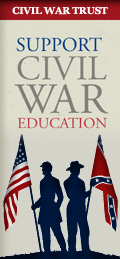|
Faces of the Confederacy, An Album of Southern Soldiers and Their Stories
By Fred L. Borch, Regimental Historian & Archivist
On Point (The Judge Advocate General's Legal Center and School, Charlottesville, Va.)
Fall 2009
This book is a companion to the author's highly acclaimed Faces of the Civil War: An Album of Union Soldiers and Their Stories, also published by Johns Hopkins. Coddington, an accomplished writer who has a regular column in the monthly newspaper Civil War News and a website (www.facesofwar.com) has brought together seventy-seven photographic portraits of men who wore Confederate gray between 1861 and 1865.
Although photography was not yet twenty-five years old when the Civil War began, two-and-one-half by four inch photographic portrait cards were all the rage by the time the conflict started. These visiting cards or "carte de visite" as they were known, were popular primarily because they were inexpensive: $1.00 bought 25 cards or more. But they also were popular because, for both Union and Confederate soldiers, this was a practical and thoughtful way to leave a memento behind with "family, friends, and sweethearts before going off to war." No soldier going off to war wants to be forgotten by his loved ones, and these carte de visite were a "memory aid" for those who he left behind.
For Coddington, these photographic portraits of young Southerners are a window into history because each photograph, when combined with a 400-500 word narrative about the person, brings that soldier to life. As he explains (p. xvii), the photographs "offer a unique perspective on the Civil War and contribute to a better understanding of the role of the common soldier." Perhaps most importantly, the book differs from other works about Confederate soldiers because it does not place their lives "in the context of a campaign, battle, or history of a military unit."
The photographs selected for publication are excellent and the vast majority of the biographical narratives in Faces of the Confederacy are interesting. But some are fascinating, if not compelling. For example, the third carte de visite (pp. 7-9) is that of James "Jim" Porter Parker. He entered the U.S. Military Academy in 1857 and soon was best friends with a cadet named George Armstrong Custer. But, while Custer graduated from West Point in 1861, Parker was dismissed shortly before graduation for too many demerits. Despite his misconduct, however, the Union Army — desperate for experienced soldiers after the outbreak of the Civil War in April 1861---offered Parker a commission as a brevet second lieutenant. He accepted it and reported for duty, but then resigned when he decided he could not fight against the Confederacy. Parker subsequently joined the First Mississippi Light Artillery as a lieutenant colonel and fought at Vicksburg. Taken prisoner in July 1863, Parker spent the next two years in Northern prisons. After the war, Parker settled in New Mexico Territory, where he worked as a surveyor. He died in 1918, aged 79 — having never married and outliving his old friend Custer by more than forty years.
Another fascinating portrait and biography belongs to George Washington Chilton (pp. 229-231) "a pro-slavery zealot" who lived in Tyler, Texas and began the Civil War as a major in the Third Texas Cavalry. In 1861, he led troops in battle at Wilson's Creek, Missouri and again at Chustenahlah, Indian Territory (today's Oklahoma). But Chilton earned the undying enmity of many when, in March 1863, he led 150 soldiers on an unauthorized mission into Mexico to capture three Texans who were officers in the First Texas Cavalry, a unit composed of volunteers loyal to the United States. Chilton and his men caught the Union officers and Chilton ordered one man to be hanged. The Mexican government protested this violation of its territorial sovereignty, and Chilton was reprimanded by his superiors. He was not, however, dismissed from the Army, and served until the end of hostilities in 1865. But "the lynching of Montgomery tarnished Chilton's reputation and dogged him for the rest of his days." He suffered from alcoholism and went on "periodic binges." Chilton died in 1884, aged 56.
This is a beautiful book and the publisher's use of high quality paper ensures that the images are superb. The only significant shortcoming — a minor criticism — is that there is no list of the seventy-seven soldiers profiled Faces of the Confederacy. It would have been helpful to list all soldier photographs (and narratives) in the table of contents, especially since the compilation is not arranged in any discernable order (neither alphabetically or chronologically, or by rank or geographic origin). The notes, references and index, however, are first class.
This unique book deserves a wide audience and will appeal to military historians generally, and students of the Civil War in particular.
|
|
